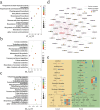High-quality Lindera megaphylla genome analysis provides insights into genome evolution and allows for the exploration of genes involved in terpenoid biosynthesis
- PMID: 40655325
- PMCID: PMC12247515
- DOI: 10.1093/hr/uhaf116
High-quality Lindera megaphylla genome analysis provides insights into genome evolution and allows for the exploration of genes involved in terpenoid biosynthesis
Abstract
Lindera megaphylla, a Lauraceae species, is valued for timber, horticulture, landscape architecture, and traditional medicine. Here, a high-quality genome of L. megaphylla was obtained at the chromosome level. A total of 96.77% of genomic sequences were mapped onto 12 chromosomes, with a total length of 1309.2 megabase (Mb) and an N50 scaffold of 107.75 Mb. Approximately, 75.91% of genome consists of repetitive sequences and 7004 ncRNAs were predicted. We identified 29 482 genes, and 28 657 genes were annotated. Gene family analysis showed expanded gene families were mainly involved in energy metabolism and cellular growth, while contracted ones were associated with carbohydrate metabolism and signal transduction. Our analysis revealed that L. megaphylla has undergone two rounds of whole-genome duplication (WGD). Our results revealed that volatile compounds in L. megaphylla leaves inhibited the growth of several fungi and bacteria. Fifty-two terpene synthase (TPS) genes were identified and classified into six subfamilies, with significant expansion observed in the TPS-b, TPS-f, and TPS-g subfamilies in L. megaphylla. Transcriptomic and metabolomic co-analysis revealed that 43 DEGs were correlated with 117 terpenoids. Further analysis revealed that LmTPS1 was significantly correlated with caryophyllene oxide content. The overexpression of LmTPS1 in transgenic tomato lines significantly increased the contents of β-caryophyllene and humulene, which further improved the resistance of transgenic tomato plants to common fungal and bacterial diseases. The integrated analysis of genome, metabolome, and transcriptome provides comprehensive insights into the evolution of L. megaphylla and clarifies the molecular mechanisms underlying the protective effects of caryophyllene against biotic stress.
© The Author(s) 2025. Published by Oxford University Press on behalf of Nanjing Agricultural University.
Conflict of interest statement
The authors declare no competing interests.
Figures









References
-
- Nawaz M, Sun JF, Shabbir S. et al. A review of plants strategies to resist biotic and abiotic environmental stressors. Sci Total Environ. 2023;900:165832 - PubMed
-
- Li S, Yan L, Venuste M. et al. A critical review of plant adaptation to environmental boron stress: uptake, utilization, and interplay with other abiotic and biotic factors. Chemosphere. 2023;338:139474 - PubMed
-
- Liu Q, Zhang CH, Fang HY. et al. Indispensable biomolecules for plant defense against pathogens: NBS-LRR and "nitrogen pool" alkaloids. Plant Sci. 2023;334:111752 - PubMed
-
- Anjali KS, Korra T. et al. Role of plant secondary metabolites in defence and transcriptional regulation in response to biotic stress. Plant Stress. 2023;8:100154
-
- Abbas F, Ke YG, Yu RC. et al. Volatile terpenoids: multiple functions, biosynthesis, modulation and manipulation by genetic engineering. Planta. 2017;246:803–16 - PubMed
LinkOut - more resources
Full Text Sources
Miscellaneous

